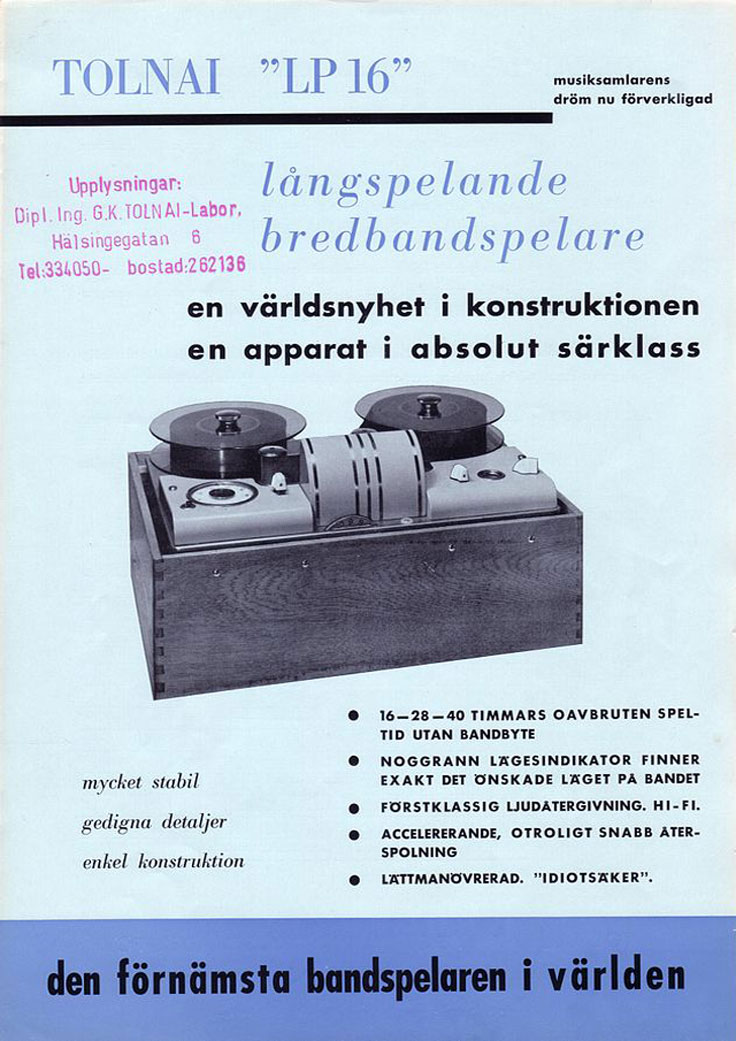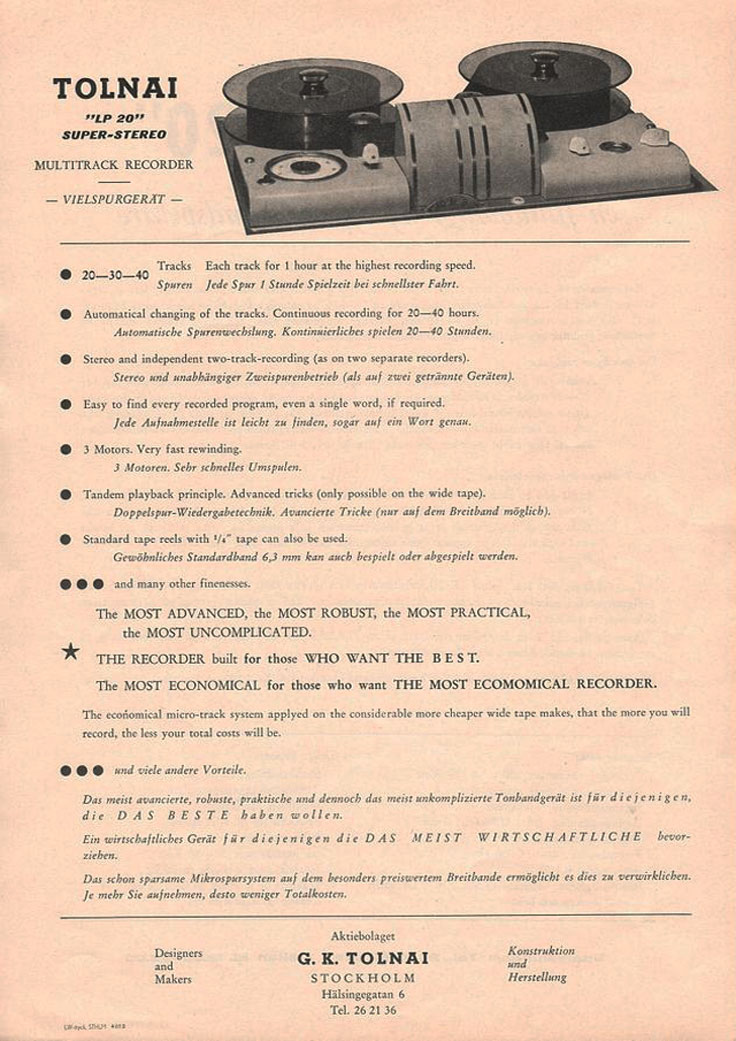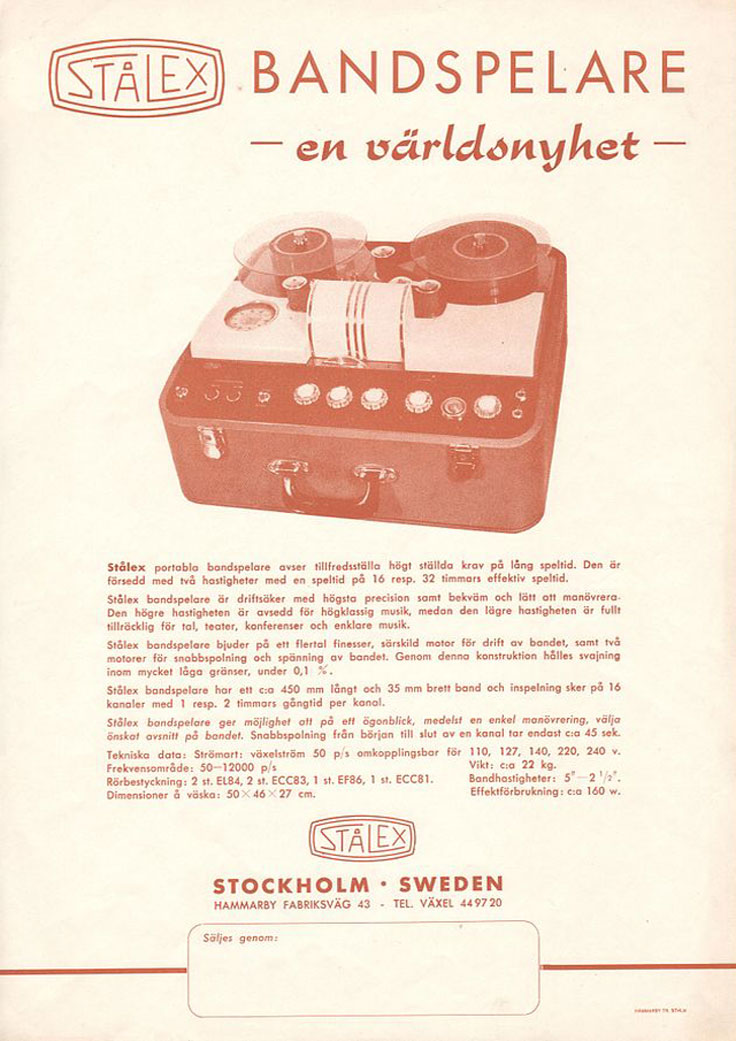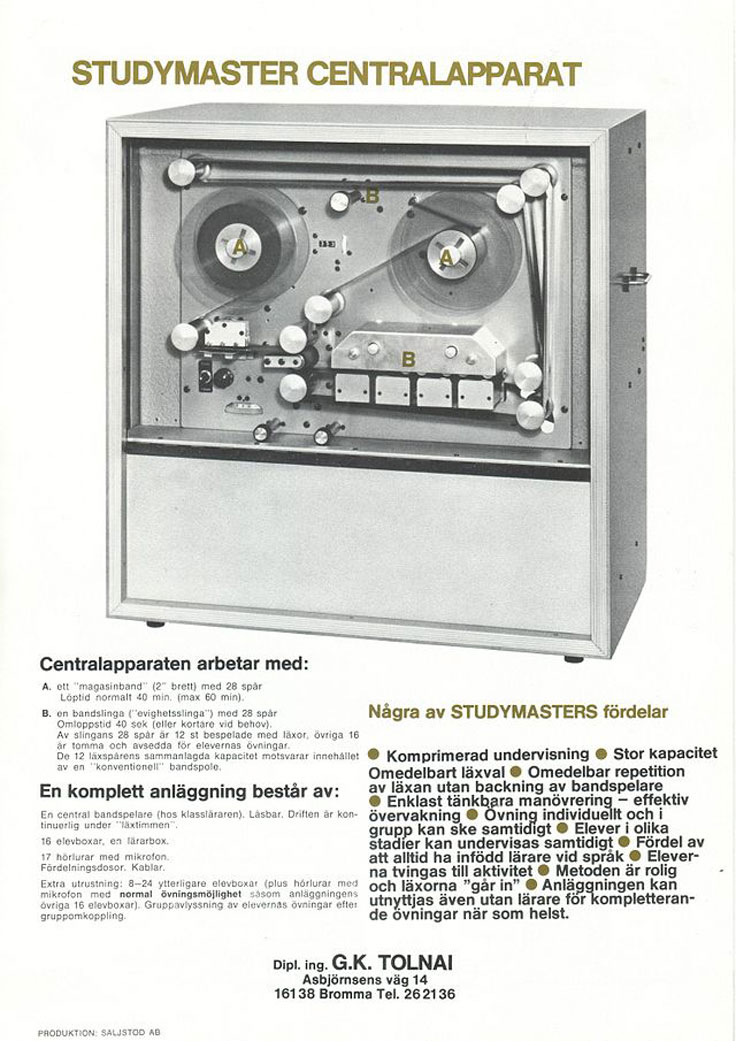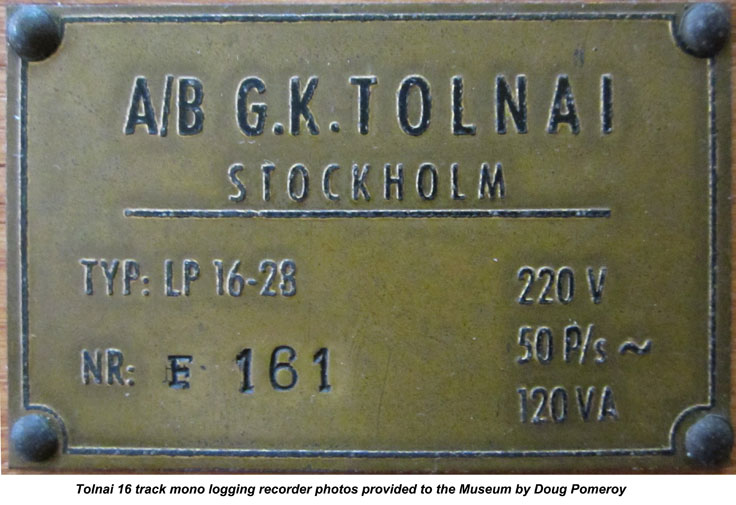
Gábor Kornél Tolnai
Tolnai 16 track mono logging recorder photos provided to the Museum by Doug Pomeroy. Summary source Wikipedia
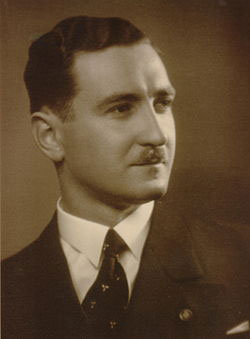 Gábor Kornél Tolnai, born November 22, 1902 in Budapest, died on February 3, 1982 in Stockholm, was a Hungarian-Swedish Diploma engineer, inventor, constructor, mechanical engineer, precision engineer, electrical engineer and a self-employed person.[1] He is best known for his inventions and patents for spinning machines, devices for the Swedish National Defense and several types of tape recorders.
Gábor Kornél Tolnai, born November 22, 1902 in Budapest, died on February 3, 1982 in Stockholm, was a Hungarian-Swedish Diploma engineer, inventor, constructor, mechanical engineer, precision engineer, electrical engineer and a self-employed person.[1] He is best known for his inventions and patents for spinning machines, devices for the Swedish National Defense and several types of tape recorders.
Biography
Kornél Tolnai was born in 1902 in Budapest in Hungary and took his Diploma Engineer's degree[2] at the Technical University of Budapest in 1924.
During the years 1928-1931 Kornél Tolnai made three inventions of his own, Centralograph, Teletachograph and Regulator, which he accomplished completely. After that he came into contact with the Swedish LM Ericsson. They bought his patents and then he was working at LM Ericsson, both in Stockholm and in Budapest for some years. He set up an experimental workshop in Stockholm and worked with designs and inventions, some of which led to patents. He was active in Sweden from 1935 and became a Swedish citizen in 1940.
in the autumn of 1928, he established himself as self-employed in Budapest with a precision-tool workshop, whose activity was based on three of his own inventions, which he had patented. All these inventions were intended for the registration and improvement of the running of the spinning machines.
During the years 1928-1931 Kornél Tolnai made three inventions of his own, Centralograph, Teletachograph and Regulator, which he accomplished completely. He manufactured the Centralograph in his own workshop, called "Dipl.ing. GK Tolnai Okl. Gépészmérnök", M. Sc. G K Tolnai Master of Science Mechanical, in Mester útca (1928-1931). The spinning of textiles is a major industry for production monitoring and registration of the running of the spinning machines in workshops and offices. It is part of the textile manufacturing process where three types of fibres are converted into yarn, then fabrics.
Construction of own tape recorders and "Tolnai Study Master" of the 1950s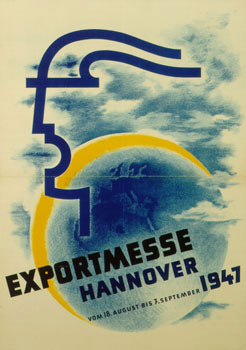
Gábor Kornél Tolnai started in 1950 AB G.K. Tolnai his own workshop and laboratory in Stockholm. The rooms was an area where he provided the tools and machinery that was required for the manufacturing the apparatus.
During the years 1950-1977 Kornél Tolnai ran his own company together with a few employees, at first on Främlingsvägen 47 in Hägersten, and then on Hälsingegatan 6 in Vasastan, both in Stockholm.
As a self-employer Tolnai regularly visited several industrial fairs in the 1950s, 1960s and 1970s, especially Hanover Fair (German: Hannover Messe), to exhibit his equipment and to market them. In 1964 he visited the World Expo in Chicago to promote his tape recorders.
Construction of Tape Recorders
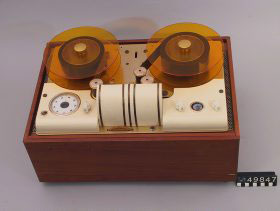 Tolnai "LP16" (left), Standard. Long Playing Tape Recorder with 16 tracks på 35 mm tape, playing time 16 hours, which was developed by Kornél Tolnai in the middle of the 1950s and was manufactured until the late 1960s. Technical museum in Stockholm.
Tolnai "LP16" (left), Standard. Long Playing Tape Recorder with 16 tracks på 35 mm tape, playing time 16 hours, which was developed by Kornél Tolnai in the middle of the 1950s and was manufactured until the late 1960s. Technical museum in Stockholm.
Tolnai "LP20", (right) Long Playing Tape Recorder with 20 tracks, which was developed by Kornél Tolnai in the middle of the 1950s and was  manufactured until the late 1960s. Technical museum in Stockholm.
manufactured until the late 1960s. Technical museum in Stockholm.
Gábor Kornél Tolnai began to construct his own tape recorders in the early 1950s when tape technology penetrated. A tape recorder, or tape machine, is an audio-storage device that records and plays back sound, usually using magnetic tape. Magnetic tape transformed the recording industry, and by the late 1950s the vast majority of commercial recordings were being mastered on tape.
Kornél Tolnai assumed already invented wire players and developed the design. Some companies were known for their excellent quality reel-to-reel tape recorders, i.e. Tandberg and Revox. Tandberg is a manufacturer of videoconferencing systems, located in Oslo, Norway (product development, sales and distribution) and New York City, USA (sales and distribution). Tandberg Radiofabrikk is now owned by LM Ericsson and the factories manufactured radios, computer equipment, language laboratories, television, tape recorders and stereo equipment. Tandberg built during the 50- and 60-century a global reputation in the fields of radio, television and tape recorders. In the 1950s and 1960s was Tandberg's tape recorder to be among the best. The magnetic tape which was in use in 1950s-1970s was 7-inch reel 1⁄4-inch-wide audio recording tapes, which were the prevalent and typical of consumer use. ReVox is a brand name of Swiss audio equipment created by Studer in the 1950s.
Kornél Tolnai constructed tape recorder for cafés, known as café machines. He designed and received patents on a tape recorder with a wide band up to 40-hour channels. Standard models are called "LP16" with 16 channels on 35 mm tape, duration 16 hours, Special versions "LP24" with 24 channels on 50 mm tape, duration 24 hours and Special versions "LP28" with 28 channels on 35 mm tape, duration 28 hours and Super "LP28" with 16-28 channels with variable channel width, duration 16–28 hours.
Kornél Tolnai sought to get the perfect stereophonic sound (Greek, stereos = "solid" and phōnē ="sound"), commonly called "stereo", on new constructions of tape recorders. Stereo or stereophonic sound is the reproduction of sound using two or more independent audio channels through a symmetrical configuration of loudspeakers in such a way as to create the impression of sound heard from various directions, as in natural hearing. It is often contrasted with monophonic, or "mono" sound, where audio is in the form of one channel, often centered in the sound field (analogous to a visual field).
Sound recording and reproduction is an electrical or mechanical inscription and re-creation of sound waves, such as spoken voice, singing, instrumental music, or sound effects. The two main classes of sound recording technology are analog recording and digital recording. Analog (or analogue) recording (Greek, ana = "according to" and logos = "relationship") is a technique used to store signals of audio or video information for later playback. In digital recording, the analog signal of video or sound is converted into a stream of discrete numbers, representing the changes in chroma and luminance values (video) orair-pressure (audio) through time, thus making an abstract template for the original sound or moving image. In 1967, the first digital audio magnetic tape recorder is invented. A 12-bit 30 kHz stereo device using a compander to extend the dynamic range.
Summary source Wikipedia
Tolnai 16 track mono logging recorder photos provided to the Museum by Doug Pomeroy

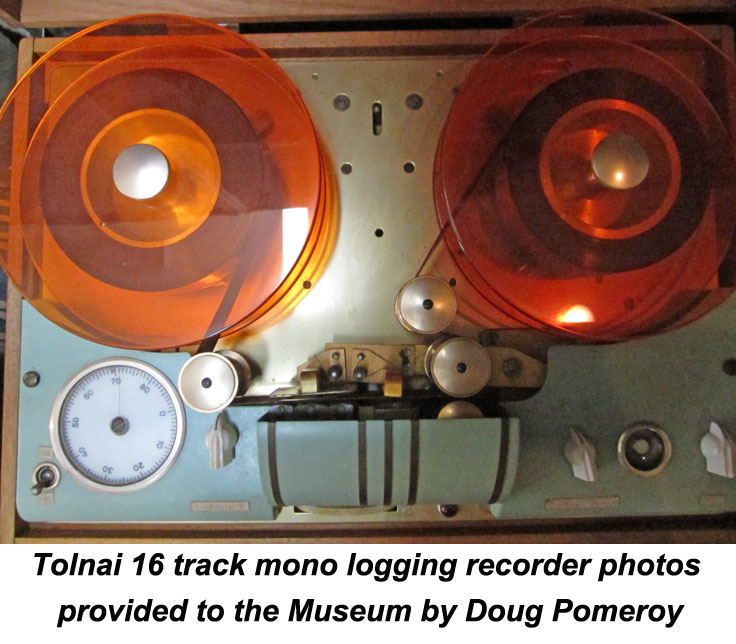
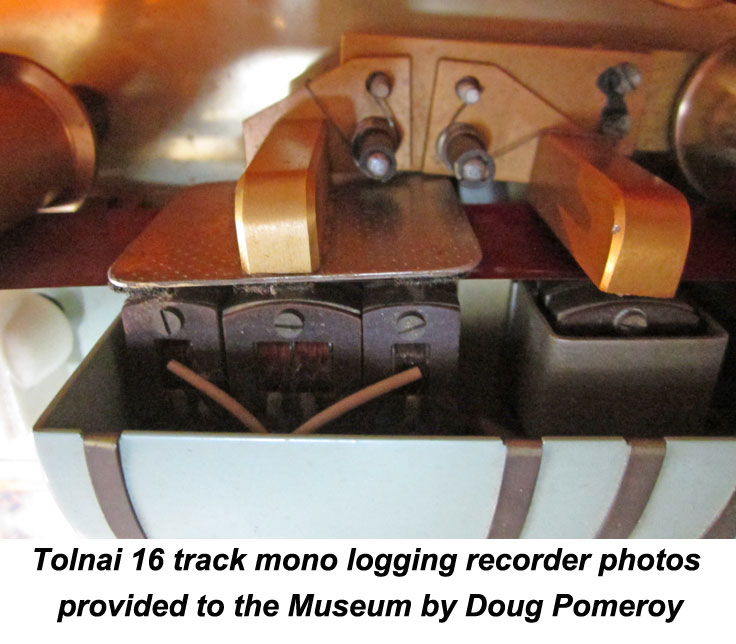
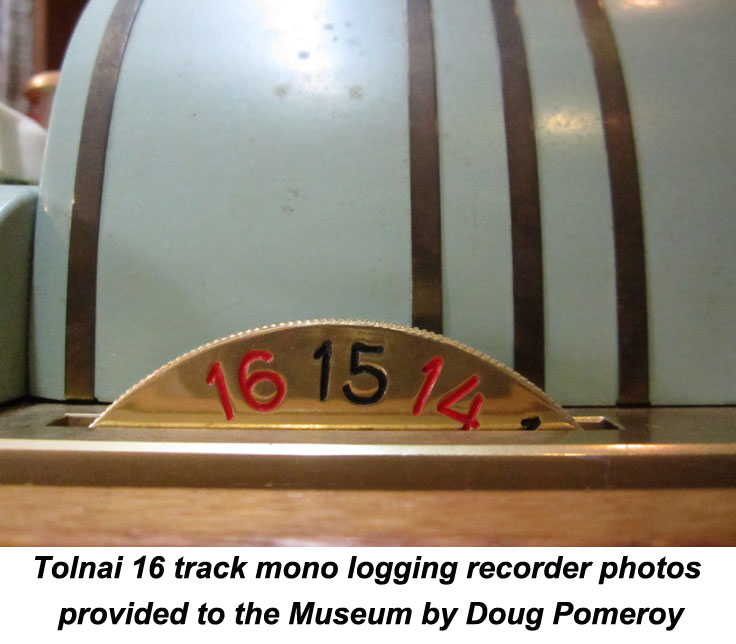
Much more about Tolnai
